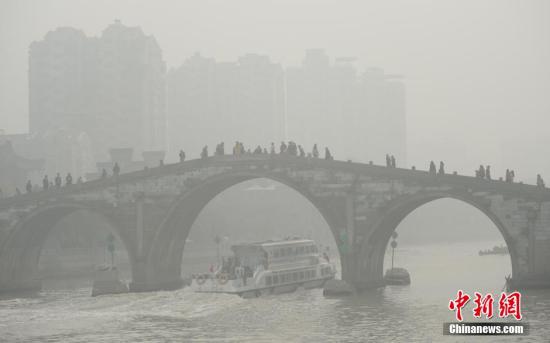Zhejiang's choking days rise by 20 times
 0 Comment(s)
0 Comment(s) Print
Print E-mail Xinhua, December 12, 2013
E-mail Xinhua, December 12, 2013
Zhejiang Province, an economic powerhouse in the Yangtze River Delta, now has over 20 times the number of hazy days as it did 50 years ago, a research report has revealed.
 |
|
Zhejiang Province, an economic powerhouse in the Yangtze River Delta, now has over 20 times the number of hazy days as it did 50 years ago. |
The average number of hazy days in Zhejiang from the 1960s to the early 1990s was around seven. The figure rose to almost 200 after the millennium, said a report on the province's hazy weather.
Vehicle exhaust and industrial fume are blamed as the biggest causes, said the report by the Environmental Science Research and Design Institute of Zhejiang Province, which is in east China.
A project team collected and analyzed data from the provincial and local environmental and meteorological departments covering the past half a century.
Heavy smog shrouded north and east China on Saturday, with highways closed and flights delayed or canceled.
Cities in Zhejiang and its neighboring Shanghai municipality have been enveloped in grey sky for several days. Many pedestrians have been wearing masks.
The coastal province is known for its prosperous local economy. Private enterprises took off in the 1980s when China started with its market economic reforms.
But along with industrialization has come more smog.
Zhejiang's capital city Hangzhou and other industrial cities, such as Wenzhou and Huzhou, had on average over 40 hazy days annually before 2000.
"The number of hazy days showed an explosive growth after 2000," said Jin Jun, the team leader of the project and the deputy director with the institute.
"Some major cities in Zhejiang have seen an annual average number of 150 hazy days. In some cases about 200 hazy days -- about 30 times the number before reform and opening at the end of the 1970s," said Jin.
Vehicle exhaust is the primary cause of the increasing smog in downtown areas, the report said.
Though the report is based on Zhejiang, it is representative of the country. The main components of the haze are vehicle emissions and industrial sewage which are formed by dust, sulfuric acid and vitriolic acid, said Jin.
Diesel vehicles are the "prime culprit" that cause emissions of PM 2.5, a key indicator of air pollution. Oxynitride which is released from gasoline vehicles easily become particle pollutants, which also worsens air quality, said the report.
"Zhejiang used about seven million tonnes of gasoline and nine million tonnes of diesel last year, which makes the province the second largest consumer of these two fuels nationwide," said Wu Jian, a senior engineer with the institute.
At the end of June, Zhejiang had 13.38 million registered vehicles, and about 8.39 million were gasoline cars.






Go to Forum >>0 Comment(s)